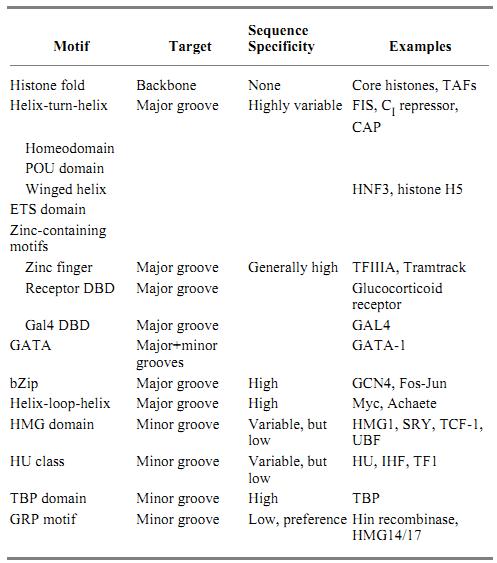


 النبات
النبات
 الحيوان
الحيوان
 الأحياء المجهرية
الأحياء المجهرية
 علم الأمراض
علم الأمراض
 التقانة الإحيائية
التقانة الإحيائية
 التقنية الحيوية المكروبية
التقنية الحيوية المكروبية
 التقنية الحياتية النانوية
التقنية الحياتية النانوية
 علم الأجنة
علم الأجنة
 الأحياء الجزيئي
الأحياء الجزيئي
 علم وظائف الأعضاء
علم وظائف الأعضاء
 الغدد
الغدد
 المضادات الحيوية
المضادات الحيوية|
Read More
Date: 27-11-2020
Date: 10-12-2015
Date: 20-11-2020
|
DNA-Binding Proteins
DNA binding proteins serve two principal functions: to organize and compact the chromosomal DNA and to regulate and effect the processes of transcription, DNA replication, and DNA recombination. The organization of chromosomal DNA is accomplished by abundant proteins which can bind to many sites and lack sequence specificity. In Enterobacteria this function is performed by FIS, H-NS, and HU proteins and in eukaryotic nuclei by the histone octamer and the linker histones, H1 and H5. By contrast, regulation of the enzymatic processes that manipulate DNA requires precise targeting to particular DNA sequences. This involves the specific recognition of the base sequence by a protein or proteins. Such proteins act genetically as repressors or activators either by themselves or in combination with corepressors or coactivators.
DNA binding is specified by a large number of disparate protein motifs. Within any particular class of motif the degree of sequence selectivity is highly variable, eg, among proteins with the helix-turn-helix-motif the lac repressor shows a high degree of sequence specificity whereas the FIS protein possesses little. The most commonly encountered types of motif are listed in Table 1.
Table 1. Commonly Encountered Types of Motif

Frequently more than one type of binding motif is found in a particular protein. In both the l CI repressor and the Hin recombinase DNA binding by a helix-turn-helix motif is stabilized by additional interactions mediated by an extended strand tracking along the minor groove. Similarly binding in other proteins may be stabilized by contacts between extended peptide loops and the sugar-phosphate backbone. Bivalence, or the ability to bind to two distinct double-helical surfaces, is a characteristic of some proteins, notably the globular domain of histone H5, which can bind two adjacent duplexes, and the l Int protein, which can define a DNA loop.



|
|
|
|
تفوقت في الاختبار على الجميع.. فاكهة "خارقة" في عالم التغذية
|
|
|
|
|
|
|
أمين عام أوبك: النفط الخام والغاز الطبيعي "هبة من الله"
|
|
|
|
|
|
|
قسم شؤون المعارف ينظم دورة عن آليات عمل الفهارس الفنية للموسوعات والكتب لملاكاته
|
|
|